
Motorized Wheelchair
Product Guide and Recommendations
A motorized wheelchair is ideal for elderly who are unable to self propel a standard wheelchair - either just for longer distances or all the time.
This could be due to decreased strength, endurance and/or coordination.
Maybe they use a light weight wheelchair in their home and want to use a motorized wheelchair outside the home when they go to the mall, downtown or other locations in the community.
Or maybe their health prevents them from using a standard wheelchair at all and they will benefit from having a battery powered version.
This is sometimes the case for elderly with respiratory and cardiac issues.
Whatever the case, a motorized wheelchair can enable some elderly to be safe and as independent as possible.
Overview
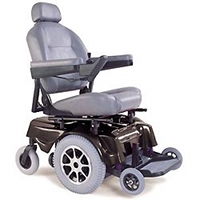
A motorized wheelchair is also referred to as an electric wheelchair and/or power wheelchair. It's battery powered with 4-6 wheels depending on the model/style.
They are mainly used by elderly who have limited strength in their arms and torso, and thus need a wheelchair that is propelled by an electric motor.
They are typically controlled using a joystick that is located at the end of the armrest. However, for elderly who cannot drive using a joystick (ex. spinal cord injury, etc) they can use a breathing device or headrest style controls.
Many have a control for setting the speed of the wheelchair. When using the chair indoors, it is recommended that you use a low speed. A higher speed may be more appropriate outdoors.
They are available in four main designs: rear-wheel drive, mid-wheel drive, front-wheel drive and travel/portable styles - all of which are discussed below.
Who Should Use?
They are an excellent choice for people who are unable to propel themselves in a light weight wheelchair. This could be due to decreased strength, coordination, balance, endurance and many other health issues affecting the elderly.
Power wheel chairs allow seniors to be as independent as possible, since they do not require someone to push their chair. They are very manoeuvrable and can be used both indoors and outdoors.
That being said, it is usually better for a senior's health to use a standard wheelchair if they can propel one. Elderly can lose their strength and endurance if they start relying on a motorized wheelchair when they do not need one.
They are also only appropriate for elderly with good safety awareness, judgement, and mental abilities.
Who Should Not Use?
A motorized wheelchair is not the same as an elderly scooter
A scooter is better for outdoor use to go to the grocery store, visit friends and attend community events. Seniors who use a scooter will need to be able to walk (with or without a mobility aid) as they cannot be easily driven indoors.
A motorized wheelchair is better indoors, can also be used outdoors and can be used a primary means of mobility.
Elderly who use a motorized wheelchair typically have significant difficulty walking safely.
Elderly with poor cognitive abilities, safety awareness and judgement are not appropriate for using a motorized wheelchair as it puts themselves as well as others at risk.
Types
There are a wide range of different makes and models. Some are superb outdoor performers, but are too bulky to easily maneuver indoors. Others can be disassembled to fit into the trunk of a large car, but generally have restricted weight limits. Others can navigate your home's narrow hallways, but are unsuitable for heavy outdoor use.
The main advantages/disadvantages of each design are described below:
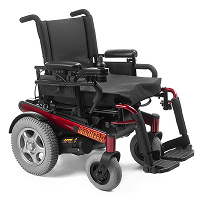
Rear-Wheel Drive
Advantages:
- Excellent outdoors
- Usually have powerful motors
- Usually have larger battery capacity (ie. longer range)
- Typically the fastest chair design
- Good suspension for bumps and ride comfort over uneven ground
Disadvantages:
- Not as manoeuvrable indoors as other designs
- Usually wider and longer than other designs
- Requires a larger turning radius
- More likely to tip onto the anti-tippers when going up steep inclines
- Leg rests typically stick out further on this style - increasing the turning radius
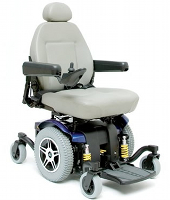
Mid-Wheel Drive
Advantages:
- Very maneuverable which makes them good indoors.
- Driver sits roughly in the middle of the chair so the weight and size is evenly distributed front/back
- Has the smallest turning radius
- Their excellent manoeuvrability make them ideal for indoor use (especially small apartments)
- The most stable for hills as they have castors in front and back
Disadvantages:
- Not as good outdoors as a rear wheel drive model.
- Do not have the suspension features as a rear or front wheel drive
- Are the easiest to get stuck or high centred because the drive wheels are in the middle
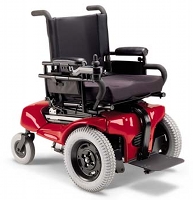
Front-Wheel Drive
Advantages:
- Stable for going both up and down hills/inclines
- Good turning radius
- Can negotiate tight corners easily
- Good suspension for bumps and ride comfort over uneven ground
- Better at climbing over obstacles than other designs
Disadvantages:
- Most of the chair base is behind the driver so it takes getting used to having the chair swing around behind you
- Typically the slowest chair as they are not as stable at high speeds
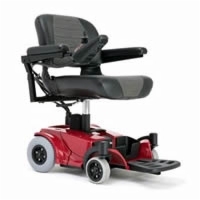
Lightweight Indoor/Light Outdoor Motorized Wheelchairs
Advantages:
- These wheelchairs are generally designed for indoor use, light outdoor use (just on sidewalks around senior housing communities) or to be portable for travel.
- They work best for people who do not use a wheelchair all the time or for light users (ex. live in seniors community and just use it to go to the dining room for meals.)
- Some models can be disassembled or folded up for easy storage or transporting in the trunk of a car.
Disadvantages:
- They are not as sturdy
- Still relatively heavy even taken apart (needs to be considered if seniors are thinking they will be putting in trunk of car for transport on a regular basis
- Do not have good suspension so ride is rougher on uneven ground
- Even though the chair folds for storage in a car trunk, they are heavy to lift into the trunk.
- The battery itself can weigh 30 pounds.
What about Elderly Scooters?
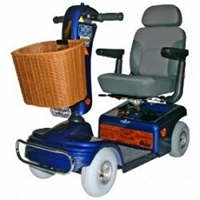
A motorized wheel chair has better maneuverability than a typical elderly scooter. It has a smaller turning radius so you can make quick, tight turns in confined spaces.
Power wheelchairs accommodate more functions for seating and postural support than a scooter, including recline and tilt options. They have tire, wheel drive design options, and can handle more terrains - indoor and outdoor.
They are also better for people with shoulder or hand strength as you just need to use a few fingers to propel a motorized wheelchair joystick. For a scooter, you have to hold your arms and shoulders up for long periods of time.
A scooter is great for those who are walking in their homes (with or without a mobility aid such as a walker) but want a way to go to the grocery store, get the mail and other short trips in the community.
However, a motorized wheelchair is great for elderly who are not safely ambulating in their home and want something battery powered they can use in their home and in the community. They will also need to be able to customize the seating as they will be spending extended periods of time sitting in it.
Scooters for elderly are ideal for outdoors as they can be faster and have more options for carrying items (trailer, basket, etc).
How to Choose?
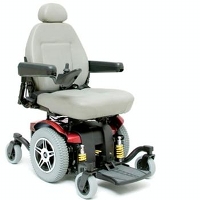
There are a number of questions you should consider, including:
- For outdoor use, what grade or incline can it handle?
- Is there a speed control and how fast and slow can it go?
- Does it come with bumpers or something similar to prevent damage to furniture and walls?
- Does it come with a a basket? If not, can one be added?
- What is the weight limit of what it can carry?
- How will you use the wheelchair, indoors, outdoors, or both?
- Will you need to transport it? (If so, how often and in what type of vehicle?)
- What weight capacity will you need, standard or heavy-duty?
- What seating style will you find most comfortable, captain's chair, solid pan with cushion, or rehab?
- Which leg rest and armrest style might best meet your needs?
- How important is speed?
- How much battery range do you foresee needing?
- If you will be using the motorized wheelchair outside, will you be climbing hills and curbs? Certain power wheelchairs are appropriate for what we call outdoor "light duty", but do not have the ground clearance, power, or wheel size needed for small hills or curbs.
- What is the narrowest width that my chair must pass through? If you plan to use your electric wheelchair in your home, it must fit through your narrowest doors and spaces. Some chairs excel at this task, but not at others (such as outdoor use).
It is very similar to buying a car. There are compromises that need to be made. A motorized wheelchair that is great indoors that is smaller, can turn on a dime and is narrower MAY not be as good outdoors as it doesn't have the same power, big wheels as other chairs designed for excelling outside. It's choosing the best wheelchair that suits their lifestyle and needs.
Recommended Features
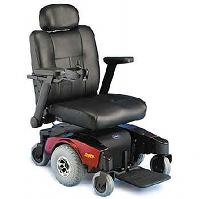
A good motorized wheelchair will have:
- Accessories - The accessories that the senior needs are available for the model/style you are interested in
- Flip up armrests - Makes transferring in/out safer and easier
- Flip up/out foot rests - Makes transferring safer and easier
- Good battery capacity - So the wheelchair will not run out of battery during the day
- Appropriate design - Read section on types to determine which is best for the elderly in your life
- Manufacturer has a good reputation - This will ensure a reliable product that will likely be backed by a warranty and good customer service
How to Fit
Fit is extremely important if the senior plans on using the motorized wheelchair as their primary means of mobility. Depending on where they are living and their ability to transfer to other seating (recliner chair, bed, etc), they may be spending hours sitting in the chair. This can be a potential issue for skin breakdown if the proper cushion and backrest is not in place.
There are three basic measurements used in fitting a reclining wheelchair.
- Hip width - This is used to determine the width of the seat
- Thigh length - This is used to determine the depth of the seat
- Knee to ground height - This is used to determine the seat height and leg rest length
- Back height - This will determine the back rest height
How to measure (use a soft sewing measuring tape or a string and measure string with measuring device):
- Have the senior sit in a kitchen chair
- Measure hip width at widest part
- Measure from back of knee to lower back/bottom (keep measuring tape parallel to floor)
- Measure from back of knee to floor (have them wear their regular shoes) - this will determine the space between the cushion and the leg rest
- Measure from lower back/bottom to base of neck - this will determine back rest height
Accessories
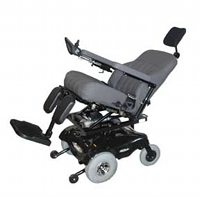
They can be easily customized to meet the senior's specific needs:
- Backrests: Special backrests that assist with posturing and provide extra back support.
- Headrests: Variety of styles to support the senior's head/neck
- Cushions: Special seat cushions that also assist with posturing, prevent slipping, and help to prevent skin breakdown. You can purchase special footrests and armrests, as well.
- Bags: Bags that attach to the back/side of the chair to carry items
- Cup Holders: Convenient drink holders
- Tilt: Tilts the entire seat assembly and footrests upwards to a 45-degree angle
- Recline: A feature that reclines the seat back
- Upgrade suspension: Spring suspension which offers a smooth ride on uneven outdoor surfaces
- Tie downs: So the motorized wheelchair can be tied down in a motor vehicle
- One piece footplate: - Alternative to two footrests.
- Seat belt: - For positioning and comfort.
More information on accessories: Power Wheelchair Accessories
How Much Do They Cost?
They range in price from $1,600 to well over $10,000, depending on the features and customization needed.
Other Types of Wheelchairs
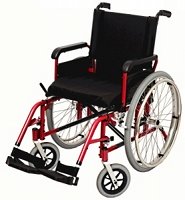
There are several other types of wheelchair including:
- Transport wheelchair - A portable lightweight wheelchair designed for pushing seniors who cannot walk long distances.
- Light weight wheelchair - A wheelchair for more regular daily use - two large wheels and two small wheels making it possible for the elderly to self-propel.
- Reclining wheelchair - A manual wheelchair that has a reclining back to improve comfort and positioning.
- Shower wheelchair - Designed to get wet in an accessible shower.
Return to Mobility Products for the Elderly
Return to Equipment for Seniors
Return to Elderly Care Products
Return to Caring for Aging Parents


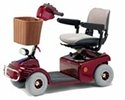



New! Comments
Have your say about what you just read! Leave me a comment in the box below.